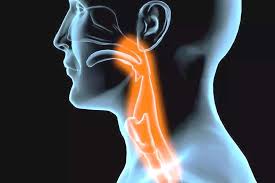
Dysphagia is to have difficulty in swallowing or even experience pain during swallowing (odynophagia). Some people may be completely unable to swallow, and that is how eating becomes a challenge. Often, dysphagia makes it difficult to take in enough calories and fluids to nourish the body and can lead to additional serious medical problems.
There are three general types of dysphagia
-
Oral dysphagia (high dysphagia) — the problem is in the mouth, sometimes caused by tongue weakness after a stroke, difficulty chewing food, or problems transporting food from the mouth.
-
Pharyngeal dysphagia — the problem is in the throat. Issues in the throat are often caused by a neurological problem that affects the nerves (such as Parkinson’s disease, stroke, or amyotrophic lateral sclerosis ).
-
Esophageal dysphagia (low dysphagia) — the problem is in the esophagus. This is usually because of a blockage or irritation. Often, a surgical procedure is required.
It is worth noting that pain when swallowing (odynophagia) is different from dysphagia, but it is possible to have both at the same time. And, Globus is the sensation of something being stuck in the throat.
The causes of dysphagia
Dysphagia can be serious. Someone who cannot swallow safely may not be able to eat enough of the right foods to stay healthy or maintain an ideal weight. Also, Food pieces that are too large for swallowing may enter the throat and block the passage of air. Or when foods or liquids enter the airway of someone who has dysphagia, coughing sometimes cannot remove it. Food or liquid that stays in the airway could enter the lungs and allow harmful bacteria to grow, cause a lung infection called aspiration pneumonia. Swallowing disorders may also cause developing a packet outside the esophagus which swallowed foods could trap in it. someone with this problem while sleeping or lying down, may draw undigested food into the throat.
What causes dysphagia
Dysphagia occurs when there is a problem with the neural control or the structures involved in any part of the swallowing process such as a weak tongue or inefficient teeth. A stroke or other nervous system disorder may make it difficult to start the swallowing response. Another difficulty can occur when weak throat muscles, such as after cancer surgery, cannot move all of the food toward the stomach. Dysphagia may also result from disorders of the esophagus.
Dysphagia can also occur in children as the result of a developmental or learning disability. Dysphagia can be caused by problems with the:
-
mouth or throat, known as oropharyngeal or "high" dysphagia
-
esophagus (the tube that carries food from your mouth to your stomach), known as esophageal or "low" dysphagia
-
Stroke
-
Major dental problems
-
Conditions that reduce saliva (like Sjogren’s syndrome)
-
Mouth sores
-
Parkinson’s disease or other neurologic conditions
-
Muscular dystrophies
-
Blockage in the esophagus (such as from a tumor)
sign and symptoms of dysphagia
-
coughing or choking while eating or drinking.
-
bringing food back up, sometimes through the nose.
-
a sensation that food is stuck in your throat or chest.
-
persistent drooling of saliva.
-
Not being able to chew food properly.
-
a 'gurgly' wet sounding voice while eating or drinking.
-
Food or stomach acid backing up into the throat.
-
Recurrent heartburn.
-
Hoarseness.
-
Unexplained weight loss.
-
Difficulty controlling food in the mouth.
-
Difficulty starting the swallowing process.
-
Recurrent pneumonia
Suggested diet for dysphagia patients
The following are some of the permitted foods:
-
Pureed breads (also called “pre-gelled” breads)
-
Smooth puddings, custards, yogurts, and pureed desserts.
-
Pureed fruits and well-mashed bananas.
-
Pureed meats.
-
Soufflés.
-
Well-moistened mashed potatoes.
-
Pureed soups.
-
Pureed vegetables without lumps, chunks, or seeds.
It is important to avoid other foods, including
-
Non-pureed breads
-
Any cereal with lumps
-
Cookies, cakes, or pastry
-
Whole fruit of any kind
-
Non-pureed meats, beans, or cheese
-
Scrambled, fried, or hard-boiled eggs
-
Non-pureed potatoes, pasta, or rice
-
Non-pureed soups
-
Non-pureed vegetables
-
Seeds, nuts, or chewy candies




